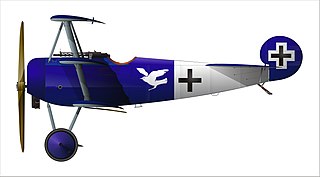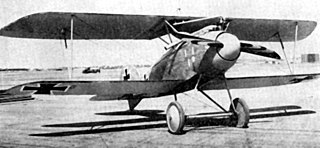Related Research Articles

Erich Loewenhardt was a German soldier and military aviator who fought in the First World War and became a fighter ace credited with 54 confirmed aerial victories. Originally enlisting in an infantry regiment even though he was only 17, he fought in the Battle of Tannenberg, winning a battlefield commission on 2 October 1914. He would serve in the Carpathians and on the Italian Front before being medically discharged in mid-1915. Following a five month recuperation, Loewenhardt joined the Imperial German Air Service in 1916. After serving as an aerial observer and reconnaissance pilot, he underwent advanced training to become a fighter pilot with Jagdstaffel 10 in March 1917. Between 24 March 1917 and 10 August 1918, Loewenhardt shot down 45 enemy airplanes, as well as destroying nine observation balloons. Shortly after his final victory, he was killed in a collision with another German pilot.
LeutnantHans Böhning, Iron Cross, was a German World War flying ace credited with 17 aerial victories. He served the German Empire first as an artilleryman, then as an aerial observer for artillery, as a fighter pilot, and finally as the Staffelführer of a fighter squadron.
Leutnant Ludwig Hanstein HOH, Bavaria's MMO was a World War I flying ace credited with 16 aerial victories.

LeutnantHans Weiss was a German World War I flying ace credited with 16 aerial victories.
Hans-Georg von der Marwitz was a German World War I flying ace credited with 15 aerial victories.

Royal Prussian Jagdstaffel 18 was a "hunting squadron" of the Luftstreitkräfte, the air arm of the Imperial German Army during World War I.

Royal Prussian Jagdstaffel 15, commonly abbreviated to Jasta 15, was a "hunting group" of the Luftstreitkräfte, the air arm of the Imperial German Army during World War I. The unit would score over 150 aerial victories during the war, at the expense of seven killed in action, two killed in flying accidents, three wounded in action, one injured in a flying accident, and two taken prisoner of war.

Royal Prussian Jagdstaffel 4, commonly abbreviated to Jasta 4, was a "hunting group" of the Luftstreitkräfte, the air arm of the Imperial German Army during World War I. The unit would score 192 confirmed victories; in turn, it would suffer 11 killed in action, 9 wounded in action, and two taken prisoner of war. It was one of the units in the famed Flying Circus.

Royal Prussian Jagdstaffel 6 was one of the original units of the Luftstreitkräfte, the air arm of the Imperial German Army during World War I.
Royal Prussian Jagdstaffel 13 was a World War I "hunting group" of the Luftstreitkräfte, the air arm of the Imperial German Army during World War I. The unit would score 108 aerial victories during the war, at the expense of twelve killed in action, one killed in a flying accident, two wounded in action, and two taken prisoner of war.

Royal Prussian Jagdstaffel 12 was a World War I "hunting group" of the Luftstreitkräfte, the air arm of the Imperial German Army during World War I. As one of the original German fighter squadrons, the unit would score 155 aerial victories during the war, at the expense of seventeen killed in action, eight wounded in action, and one taken prisoner of war.
Royal Prussian Jagdstaffel 17 was a "hunting group" of the Luftstreitkräfte, the air arm of the Imperial German Army during World War I. As one of the original German fighter squadrons, the unit would score 101 aerial victories during the war, with another 22 of the squadron's claims going unconfirmed.
Royal Prussian Jagdstaffel 14 was a "hunting group" of the Luftstreitkräfte, the air arm of the Imperial German Army during World War I. As one of the original German fighter squadrons, the unit would score 57 aerial victories during the war. In turn, the Jasta paid a price of eight killed in action, five wounded in action, and three taken prisoner of war.
Royal Prussian Jagdstaffel 46 was a "hunting group" of the Luftstreitkräfte, the air arm of the Imperial German Army during World War I. As one of the original German fighter squadrons, the unit would score 20 confirmed aerial victories over enemy observation balloons, plus thirty more over enemy aircraft. The Jasta paid a price of ten killed in action, one lost in a flying accident, six wounded in action, and three injured in accidents.

Royal Prussian Jagdstaffel 19 was a World War I "hunting group" of the Luftstreitkräfte, the air arm of the Imperial German Army during World War I. As one of the original German fighter squadrons, the unit would score 92 verified aerial victories, including ten wins over enemy observation balloons.

Royal Prussian Jagdstaffel 26 was a "hunting group" of the Luftstreitkräfte, the air arm of the Imperial German Army during World War I. As one of the original German fighter squadrons, the unit would score 177 verified aerial victories, including four observation balloons destroyed. The Jasta would pay a bloody price for its success: five pilots killed in action, nine wounded in action, and one prisoner of war.

Royal Prussian Jagdstaffel 29, commonly abbreviated to Jasta 29, was a "hunting group" of the Luftstreitkräfte, the air arm of the Imperial German Army during World War I. The squadron would score 76 aerial victories during the war, at the cost of 13 of their pilots killed in action, two killed in flying accidents, 12 wounded in action, one injured in a flying accident and one taken prisoner.

Royal Bavarian Jagdstaffel 32, commonly abbreviated to Jasta 32, was a "hunting group" of the German Luftstreitkräfte, the air arm of the Imperial German Army during World War I. The unit would score 41 aerial victories during the war, including four enemy observation balloons. In turn, they would suffer the expense of eight killed in action, five killed in flying accidents, four wounded in action, two injured in accidents, and one taken prisoner of war.
Royal Prussian Jagdstaffel 36, commonly abbreviated to Jasta 36, was a "hunting group" of the Luftstreitkräfte, the air arm of the Imperial German Army during World War I. The unit would score 123 confirmed aerial victories during the war, including 11 enemy observation balloons. In turn, they would suffer 13 killed in action, 15 wounded in action, two injured in flying accidents, and two taken prisoner of war.

Royal Prussian Jagdstaffel 50, commonly abbreviated to Jasta 50, was a "hunting group" of the Luftstreitkräfte, the air arm of the Imperial German Army during World War I. The squadron would score over 45 aerial victories during the war, including 14 observation balloons downed. The unit's victories came at the expense of five killed in action, one wounded in action, and three taken prisoner of war. The squadron was disbanded on 17 January 1919.
References
- Franks, Norman; Bailey, Frank W.; Guest, Russell. Above the Lines: The Aces and Fighter Units of the German Air Service, Naval Air Service and Flanders Marine Corps, 1914–1918. Grub Street, 1993. ISBN 0-948817-73-9, ISBN 978-0-948817-73-1.
- Franks, Norman; Van Wyngarden, Greg (2004). Fokker D VII Aces of World War 1, Part 2. Osprey Publishing. ISBN 978-1-84176-729-1.